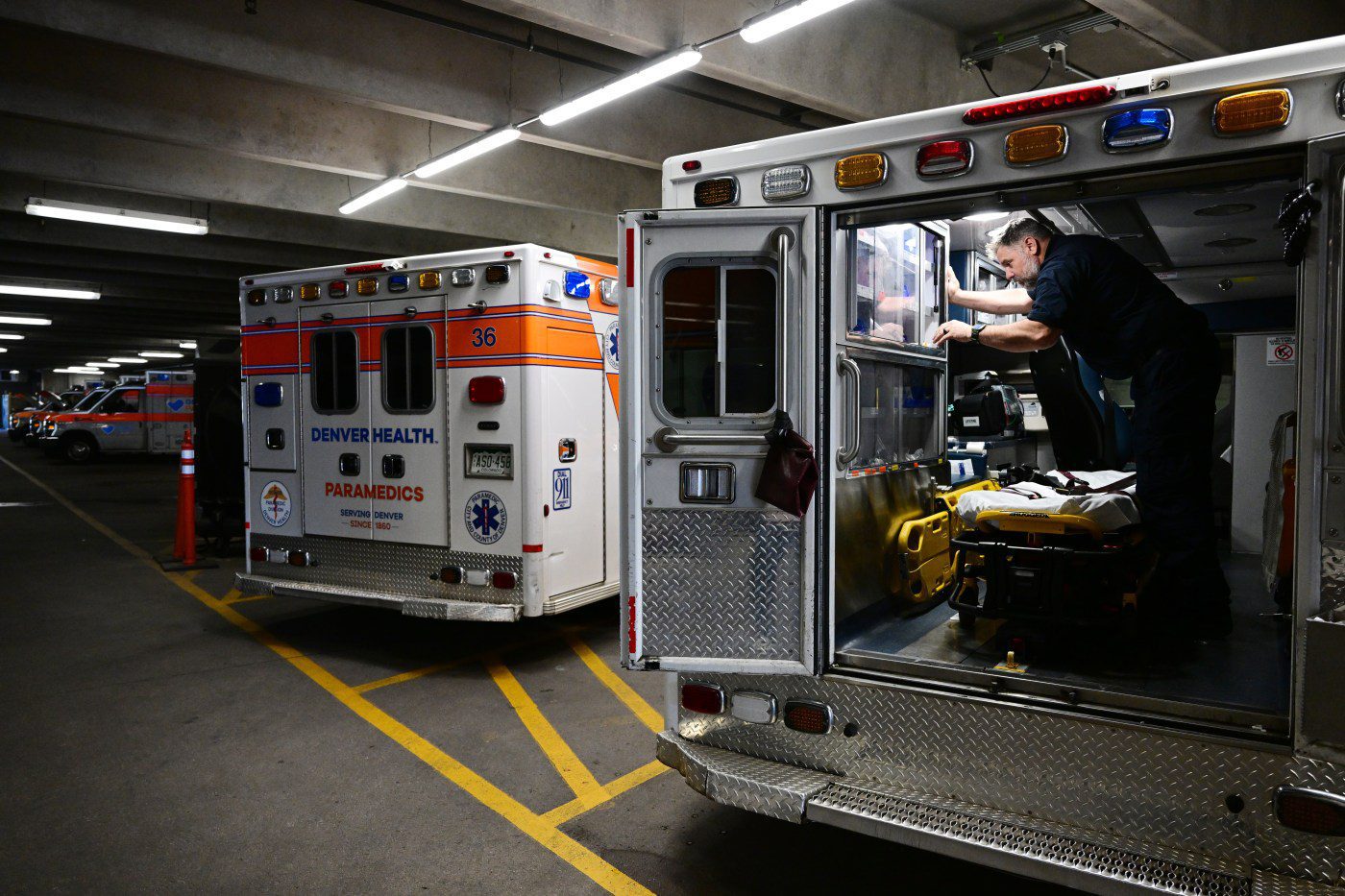Hundreds of millions of dollars will flow into Colorado over the next 17 years to try to offset the societal damage from opioid addiction, but the governments and regional councils that control the money have little guidance on how best to spend it.
Colorado will receive at least $787.7 million through nearly a dozen multi-state legal settlements with pharmaceutical companies, drug distributors and some major retailers, with $110.7 million of that total distributed since November 2022.
About 60% of Colorado’s share will go to 19 regional groupings of counties, with the state and individual communities taking smaller shares. The amount sent to municipalities, which still benefit from the regional allocations, depends on their populations and how hard the opioid crisis hit them.
So far, the regional distributions have ranged from $345,000, given to five counties in the northwest corner of the state, to $8.4 million for the region that includes only Adams County. Municipalities have received anywhere from just $121, sent to the town of Empire, to $3.9 million, which was Denver’s allocation.
Those sums won’t address all of the harm that opioid addiction has done in the state, but they offer a unique opportunity to save lives, said Marie Curran, Denver’s opioid abatement funds program coordinator. Since 2000, the state reported 11,316 deaths from opioid overdoses, including 1,292 in the most recent year with data.
“I think the money itself is significant,” she said. “It’s not going to be able to solve every issue.”
And the pot of money could still grow. Purdue Pharma, which made OxyContin, and its former owners still haven’t finalized their settlement, which would pay about $6 billion over 18 years to state and local governments, as well as qualifying individuals. The U.S. Supreme Court threw that arrangement into question last month when it ruled the Sackler family, which owned Purdue, couldn’t shield its assets from lawsuits through Purdue’s bankruptcy.
The initial payments from the finalized agreements are supposed to be the largest, however, so unless more companies settle, communities will receive smaller amounts as the years pass, though the exact amount they’ll receive in the future is uncertain. If the regions and local governments don’t have a plan for all of their allocated funds in a particular year, they can opt to have the state hold that money for them until a future year.
Communities have dozens of options to spend the settlement, and while the sums can be significant, they won’t cover every possibility, even in cities receiving millions. That forces regional councils and local governments to prioritize what needs to be tackled first and decide how best to do that, with only limited guidance.
Recipients may never be sure if they chose the absolute best use of their funds. But they’ll know if they made a wrong choice by picking something without strong evidence it works, said Rhiannon Streight, senior behavioral health consultant at the Steadman Group, a consultancy that focuses on health care and is helping five regions sort through their options for the settlement money.
For example, Drug Abuse Resistance Education — the D.A.R.E. program, most prominent through the 1980s and ’90s — is a permitted expenditure, but hasn’t been shown to reduce youth drug use, she said.
“I do think there’s a wrong way to do it,” Streight said. “There are so many right ways.”
Colorado requires the regions and 79 municipalities receiving settlement money directly to spend it on opioid- and addiction-related projects — no paving roads or cutting property taxes. Many towns and counties receiving smaller allocations decided to send their share to their region rather than administering it locally.
The 19 regional councils, largely made of elected officials, that oversee the spending have dozens of options to choose from within those bounds, though, and regions are taking very different approaches. A few are saving most of the money for one major project, such as building a treatment facility, while others are making grants to 10 or more organizations almost immediately.
The regions had to submit two-year plans for how they would spend their share of the settlement funds to the Colorado Attorney General’s Office, which is overseeing the settlements’ distribution. The Colorado Opioid Abatement Council must determine whether the planned spending is an approved use, but can’t deny it if the members believe a different approved use would be better.
The opioid settlements, like the 1998 tobacco master settlement, carry some unusual challenges, said Glenn Sterner, an assistant professor of criminal justice at Penn State University who is involved with Pennsylvania’s settlement distribution. Typically, when a community wants to do something to address substance use, it submits an application to an agency, which determines if the idea seems sound. In this case, courts are distributing the money, and while communities are required to spend it on opioid-related items, no one is giving them much guidance on how best to do that, he said.
Another challenge is that stigma still surrounds some of the interventions with the most evidence, such as offering the medications methadone or buprenorphine to people in recovery, Sterner said. If decision-makers aren’t comfortable with proven strategies, or think their communities won’t be, they may instead turn to ideas without track records, he said.
In a perfect world, every community would have a “balanced portfolio” of investments in prevention, treatment, harm reduction and recovery services, but the settlement sums are less impressive than they sound when spread out over 18 years, Sterner said. So each place will have to consider which needs are most pressing and how they can use other funding sources to achieve as much as possible, he said.
“We don’t really know what the right mix of programs and projects are” for different situations, he said.
Denver goes in on harm reduction
Communities don’t lack options to spend their settlement dollars.
In September 2022, Denver released a list of 58 possible uses for its $4.7 million initial payment. Some of the uses, such as medication-assisted treatment in jails, already had other sources of funding, and some weren’t feasible with the amount available, such as building a new treatment center. Denver received funds both as a city and as a one-county region.
Ultimately, the largest share of the $7.9 million Denver has received so far went to harm reduction, which accounted for at least $1.5 million, according to data from the attorney general’s office. Denver received allocations as both a city and as a one-county region.
Harm reduction includes tactics such as operating syringe exchanges to reduce the spread of infectious diseases and handing out naloxone to people who might need to reverse someone else’s overdose.
The Naloxone Project is using its share of the money, which has totaled about $400,000 so far, to fund training for first responders and to distribute the overdose reversal drug, which it pays for with other grants and donations. In the past year, about 1,000 Denver Health paramedics, Denver Police Department officers, mental health co-responders and Denver Fire Department personnel have taken training about naloxone, and many accepted free doses they can give out to at-risk people they encounter on their calls, Naloxone Project founder Dr. Don Stader said.
Part of the goal is to encourage first responders to think more broadly about who might be at risk. For example, police might be called to an encampment for a disturbance that doesn’t relate to opioids, but notice needles or other paraphernalia around that would lead them to believe that someone could overdose in the near future, and would have the option to leave naloxone, Stader said. Naloxone won’t solve the crisis alone, but it can prevent deaths, he said.
“It’s part of a holistic solution to the opioid crisis,” Stader said.
The group also is hoping to get some state funding to expand its training beyond the 25 agencies that currently participate, most of which are in the Denver area, said Joshua Jacoves, pre-hospital project manager for the Naloxone Project. As of the end of June, the existing partners had given out about 450 naloxone kits to the public. While they don’t know how many people used them to reverse overdoses, a few recipients have volunteered that they used their first kit and were seeking a second one, he said.
Some of the money also went to diversify the group of people working in peer support in the city. Tonya Wheeler, executive director of Advocates for Recovery Colorado, said the $338,000 the group received from Denver this year allowed it to promote a recovery coach of American Indian and Spanish descent to the role of cultural program manager, and to hire a native Spanish speaker originally from Mexico as a recovery coach. People tend to have an easier time relating to coaches who share their background, and the peer recovery workforce is still disproportionately white, she said.
“Let’s bring the proper services to the proper community using the proper support,” she said.
Some of the Denver grant also will go toward translating some of their written materials into Spanish, hiring a contractor to train the recovery coaches on diversity and inclusion and paying stipends to people serving on an advisory council to help the group be more equitable, Wheeler said. The group isn’t guaranteed to get funds every year, but Wheeler said she’s hopeful that the opioid money will offer some longer-term stability for the people they hired and the diversity work they’re doing.
“It can be disruptive to a community when we put services in and have to yank them away,” she said.
Denver also made grants to connect more people to treatment through the Colorado Health Network, and the city plans to help the Harm Reduction Action Center purchase a facility; to expand capacity at 5280 High School, which serves students in recovery; and to run a public education campaign about harm reduction, among other things, said Curran, the opioid abatement funds program coordinator for the city and county.
The regions have to balance how they’re going to address immediate needs with longer-term strategies, and have to think about how to collaborate with others working on addiction to do the most with the available funds, Curran said. Denver is talking to the other regions and the attorney general’s office to see what it can learn from different approaches, she said.
The council in Denver is trying to think 10 or 20 years out for its strategic plan, with the knowledge that it almost certainly will change within that time, Curran said. Twenty years ago, opioid addiction wasn’t on most people’s radar as a health problem, and 10 years ago, prescription pills were still the most salient threat. Since then, heroin displaced prescription pills as the top threat, before illicit fentanyl displaced it as the drug linked to the most overdose deaths.
“We don’t want to develop this plan, wipe our hands and say, ‘We did it,’ ” she said.
Construction, prevention and public messages
Some regions are betting the settlement funds are their opportunity to make a single big investment they couldn’t otherwise afford.
In its most recent report to the state, the Southwest Opioid Response District said it put 93% of the roughly $1.5 million it had received at that point toward saving up to build a “recovery campus,” with the remaining $109,000 going to grants for community organizations working on addiction. The campus is still in the planning phases and doesn’t have a site yet.
Heather Otter, project manager for a five-county economic district and facilitator of the Southwest Opioid Response District, said SWORD accepted the first applications from community organizations in June and is still evaluating them. Both the economic district and SWORD include Archuleta, Dolores, La Plata, Montezuma and San Juan counties.
The recovery campus won’t be ready for several years, at least, but it could represent a “generational solution” to the problem that people in the area don’t have anywhere to go after treatment if they don’t feel ready to return to their normal lives, Otter said. The plan is eventually to build a continuum of recovery services, ranging from supportive groups through sober living homes and the recovery campus, which will have a curriculum that residents complete, she said.
“The recovery piece is something that can endure long after we’re doing the work,” she said.
Other regions concluded that building new infrastructure didn’t make sense for them.
Broomfield, which has received a combined $725,000 as a city and a region, doesn’t have a treatment center within its borders, but in a geographically compact community, people don’t find it a great hardship to go to one of the surrounding counties for care, said Jason Vahling, director of the city and county’s Department of Public Health and Environment.
Broomfield had recently completed a community health assessment, which gave some general areas to explore, Vahling said. It then convened an advisory group, which determined the biggest priorities were preventing substance misuse, harm reduction, linking people to treatment and setting up an infrastructure to oversee the groups using the funds, he said.
Some of the strategies they’re pursuing include preventing drug use by giving young people scholarships for activities so they have less unsupervised time, training community members to recognize when someone needs help, distributing naloxone to anyone who wants it and hiring someone to help in the justice system get treatment and meet their other basic needs, Vahling said.
“We believe we need to be able to address all of those community factors,” he said.
Generally, prevention programs are most successful when they teach kids communication skills, how to make good decisions and how to handle their emotions and control their behavior, said Nathaniel Riggs, executive director of the Colorado State University Prevention Research Center.
Family programs that teach how to talk to kids and monitor their behavior in a way that doesn’t feel punitive also can help, he said. The center is working with four Colorado regions to develop their prevention plans.
“It really is about promoting the good,” because people who feel their lives are going well are less likely to engage in dangerous behavior, he said.
In contrast, evidence has shown that “scare tactics” and programs that just present information about the negative effects of drugs rarely succeed in reducing youth use, Riggs said. Bringing in one-time speakers also isn’t a good use of money, he said.
“We know those approaches don’t work, mainly because they don’t build skills,” he said. “Raising knowledge of substances and the effect that they have on the human body… is important, but it’s not enough.”
Prevention can look different from region to region.
Karina Schorr, opioid abatement council coordinator for the mountainous Region 5, said their anti-stigma campaign has an element of encouraging people to think about how they can still enjoy themselves and be part of their communities without substances. They plan to feature local people in recovery from a variety of substances, not just opioids, since people who are struggling with one drug may use others, she said.
“As a region, we’re somewhat characterized by the mountain resort towns,” she said. “It kind of comes along with a lot of substance use and so-called party culture.” Region 5 includes Summit, Eagle, Pitkin, Garfield and Lake counties.
The Region 5 council also contracted with a local group, High Rockies Harm Reduction, to distribute naloxone in places where people feel comfortable coming to pick it up, Schorr said. As is, most of the free naloxone in the area sits in county health departments, and people who use drugs may not want to advertise that fact to a government agency, she said. The group also offers peer support and help finding care to people who want to stop using drugs.
“Access isn’t (as) strong up here” as it is in the metro area, she said.
Most funding sources last only a year or two, so the councils have to shift their thinking to best use the opioid settlement funding, Schorr said.
“We’re still trying, I think, to wrap our heads around what it means to have funding for 18 years,” she said. “We’re just trying to make sure we build a long-term vision and strategy.”
Initially, the attorney general’s office asked the councils to submit two-year plans, but now they can go one year at a time, said Streight, the consultant working with regions on plans to use their settlement money. Increasingly, though, councils are looking to make plans for three to five years, so they don’t have to go through the process of redetermining their priorities annually, she said.
“Councils are getting — ‘fatigued’ maybe is the right term — and want some longer-term planning,” she said. “Programs require a little bit of time to determine if they’re working or not.”
Streight said she and the other consultants in the firm choose a handful of the available tools to help the regions they’re working with to make their decisions. Most have come in without a clear idea of what goals they want to pursue, which isn’t surprising, since the elected officials on the regional councils aren’t experts on substance use disorders, she said.
The settlement came with an appendix highlighting the strategies that have the most evidence behind them, but even those may not be right for every community, which makes it vital to talk to people in recovery and those working in addiction locally, Streight said.
They also compile data to get an idea of what resources a community has and what gaps are most important to fill, she said.
“The people who have lived this in their communities, they know what to do,” she said.
Sign up for our weekly newsletter to get health news sent straight to your inbox.
Originally Published:





